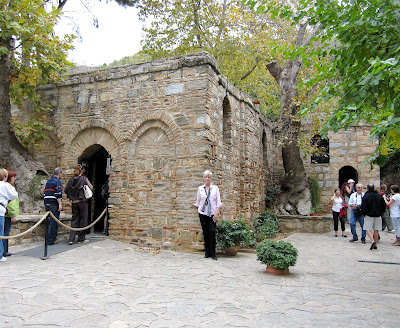Fullness, juiciness, life's abundance.
The pomegranate is a symbol of the sacred in every world religion.

Some scholars of Judaism claim it was a pomegranate that tempted Eve and not an apple. And, a single fruit is said to have 613 seeds representing the 613 commandments of the Torah, the first of which is to “be fruitful and multiply.”
In Islam, the Gardens of Paradise contain pomegranates. And, it is said that the Prophet Mohammed encouraged eating the fruit to eliminate envy and hatred.
In Hinduism, the pomegranate is a symbol of fertility and prosperity. It is often depicted in the hands of the deities, especially Durga, the invincible and supremely radiant goddess.
And, of all the gifts Buddha received in his lifetime he was most delighted by the gift of a pomegranate.
The recently published dual memoir Traveling with Pomegranates by Sue Monk Kidd (author of The Secret Life of Bees) and her daughter Ann Kidd Taylor, is full of lore on the symbolism of pomegranates in the ancient Greek and Roman cultures and also in the Christian faith. The book tells of their travels together to Greece and Turkey and of their individual quests for meaning as women in separate times of life.
I recently read this deeply inspiring book while on a voyage to the ruins of the ancient city of Ephesus in Turkey. Once one of the three largest trading centers of the Roman Empire, it was the home of the vast Temple of Artemis, one of the wonders of the ancient world.
 Ephesus is a thriving harbor city with a population of over a million, Ephesus has the best-preserved ruins of those times. Its stand-out sites are a two-story library and a theater that held 25,000.
Ephesus is a thriving harbor city with a population of over a million, Ephesus has the best-preserved ruins of those times. Its stand-out sites are a two-story library and a theater that held 25,000.
A statue in the extraordinary Ephesus Museum depicts the goddess Artemis with pomegranate-like breasts representing the fruitfulness of Mother Nature.


Ted and I loved the tart flavor of the dark red fresh-squeezed juice. The vendor showed me how the top of the fruit has rising points that look like a crown, making the fruit a symbol of the beauty and divinity of the Virgin Mary who lived nearby. [img 0685]

You see, Ephesus is also where the apostle John is said to have taken the Virgin Mary after the crucifixion. High atop a hill, from the Basilica of St. John, one looks down on a road that leads a short distance into the hills to the House of the Virgin Mary, where she is said to have spent her final years. Many modern-day Popes have visited the site, and though there remains controversy as to its authenticity, we were touched by the feeling of reverence there.

Below the house is a flowing spring where visitors drink and fill flasks with water said to have healing properties.
Now that I am home, still filled with memories of so many sacred sites, I sense how pomegranates celebrate in so many meaningful ways the fullness and pure lusciousness of being a woman.
May the blessings of your holiday season be as
bountiful as the seeds of a pomegranate.
Holiday Salad with Pomegranate seeds
I am looking for ways to use pomegranates during the holidays. Last week, I added some seeds to my cranberry orange relish for Thanksgiving, and today I am sprinkling them on a spectacular salad of baby spinach, Gorgonzola cheese, spicy pecans from Trader Joes, and shredded rotisserie chicken from Costco.
Are you familiar with the Costco chickens? They are large, brined, and bursting with flavor! Only $4.99, I buy one every week and remove the skin as soon as I get home. Then I slice the breast meat into thin slices for sandwiches or to serve with rice or mashed potatoes, and shred the dark meat to use in salads or a seasonal stew I devised to serve as a buffet dish:
SOUTHWESTERN STROGANOFF
For about 16 servings
2 cans (7ounces each) whole green chiles, rinsed, seeded, and cut into thin strips
½ cup (1 stick) butter
2 large white onions,minced
4 garlic cloves, minced
¼ cup chili powder
Pinch of ground cloves
½ cup all purpose flour
4 cups strong chicken or turkey broth
1 ¼ cups white wine, or 1 cup dry Vermouth
4 cups shredded cooked turkey breast or chicken
2 cups sour cream
To garnish and serve:
1 ripe avocado, peeled, pitted, ad cut in thin wedges
½ cup chopped cilantro (fresh coriander), optional
Seeds from ½ a ripe pomegranate
Note: If the broth you use is not richly seasoned, flavor the finished Stroganoff to taste with chicken stock base or bouillon cubes dissolved in hot water.
Melt butter in a heavy pot of at least 6-quart capacity over medium-high heat. Sauté the onions and garlic for about 5 minutes until the onion is transparent. Stir in the chli powder and cloves and stir for a minute or so to toast them, then add the flour. Cook over low heat for about 3 minutes to toast the flour lightly and remove any raw taste. Gradually add the chicken or turkey broth, then the wine or vermouth and chiles. Bring to a simmer and stir until thickened. Lower the heat and simmer for ten minutes.
Add the shredded chicken or turkey and simmer slowly just to heat it through.
Just before serving, stir sour cream into the hot mixture, taking care not to boil it, which might curdle the sour cream.
Transfer to a warm serving dish or chafing dish. Garnish the top of the Stroganoff with slices of avocado, cilantro and pomegranate seeds. Serve with rice or noodles.
To prepare in advance: The dish may be made ahead up to the point where you have added the chicken or turkey. Store in the refrigerator for 3 days or in the freezer for a month or more. Thaw if frozen and reheat in a heavy saucepan or crock-pot, stirring in the sour cream within a few minutes of serving. Reheat any leftover Stroganoff in a double boiler over barely simmering water.

And, here are some imaginative uses of pomegranates I've found in my holiday rounds. The first is a platter of lamb chops catered by The Kitchen in Pasadena.

The second, a spectacular salad I enjoyed on our twentieth anniversary at the Restaurant at Getty Museum.







No comments:
Post a Comment